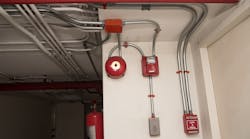Part II of Art. 760 of the National Electrical Code provides the requirements for non-power-limited fire alarm (NPLFA) circuits. Some highlights include:
- The power sources must comply with Chapters 1 through 4 [760.41(A)].
- Output voltage cannot exceed 600V.
- The disconnect can be secured in the “ON” position.
- The branch circuit cannot supply other loads [760.41(B)].
- For conductors 14 AWG and larger, do not apply ampacity adjustment and correction factors when sizing the overcurrent protection [760.43].
- The ampacity adjustment factors of 310.15(C)(1), however, apply to conductors in raceway for each conductor that continuously carries over 10% of its ampacity [760.51(A)].
- As with other kinds of circuits, locate the overcurrent protection where the conductor receives its supply. However, there are three exceptions listed in 760.45. For example, when the OCPD protecting the larger conductor also protects the smaller conductor.
- If you put NPFLA conductors in the same raceway as Class 1 power supply conductors, then all conductors must be insulated for the maximum voltage of any conductor in that raceway [760.48(A)].
- You can use only copper conductors [760.49(A)].




